Galician battle. Part of 3. Galich-Lviv operation
Simultaneously with the oncoming battle of the Russian 4 and 5 armies with the Austrian 1 and 4 armies between the rivers Western Bug and Vistula (Part 1, Part 2) on the left wing of the South-Western Front, the Russian 3 and 8 armies launched an offensive. This offensive is included in history as Galich-Lviv operation.
The 3 Army of Ruza and the 8 Army of Brusilov had 21 infantry and 7 cavalry divisions. They were opposed by the 3-I Austrian Army Bruderman and the Army Group Köwes as part of the 9 1 / 2 infantry and 5 cavalry divisions. The offensive of the army of Ruza, which began on 6 (19) in August of 1914, before 10 (23) in August, developed almost unhindered. Ruzsky's army had 4 corps (215 thousand people with 685 guns). The weak parts of the cover of the Austro-Hungarian army retreated almost without resistance. The Austrians showed little resistance only at Tarnopol, Ostrov and Chertkov.
Source: Kolenkovsky A. The Maneuverable Period of the First World Imperialist War 1914
Cavalry battle at Yaroslavitsy. August 8 (August 21) Russian cavalry (10-Cavalry Division of General Count F. A. Keller) defeated the Austrian cavalry (4-I Cavalry Division of General Edmund Ritter von Zaremba) in the battle of Yaroslavlitsa. A head-on battle near Yaroslavl is considered by historians to be the last cavalry battle of world history. The intelligence of the Russian division found the enemy's 10 division in front of the front, and it was decided to attack it. The enemy had an advantage in numbers (20 squadrons of Austrians against 10 Russians), and in position. The Russian cavalry was forced to first go down into the hollow, under the fire of the Austrian machine guns, and then attack from the bottom up, on the rise. In addition, the crest hid the true number of Austrians and their construction.
The dragoons and the lancers moved to the right of the hill where Keller's headquarters was located, the hussars to the left. Count Keller trained his subordinates to act and make decisions on the battlefield on their own. At the beginning of the battle the division commander gave the last order, which in many respects decided the outcome of the battle. It was received by the commander of the hussar regiment, Colonel Bogorodsky: “Keep on the ledge! Attack the flank! ”
Russian lancers and dragoons under enemy fire reached the enemy and raised his first line to the peaks (they were used according to the instructions and methodology of Keller's cavalry battle). The first enemy line (6-8 squadrons) was crushed. Then a merciless slash began, in which up to 2,5 thousand riders participated. However, the enemy had a great advantage: his second (6 squadrons) and reserve (4 squadron) lines went on the attack. Two powerful consecutive blows crushed the Russian cavalry. Dragoons and Lancers began to retreat.
An Austrian squadron broke through to the rear. Keller led the headquarters and the convoy (a platoon of Cossacks of the 1 of the Orenburg regiment) and overthrew the enemy. The critical moment has come. As a result, the outcome of the battle was decided by the 10 th Hussar Ingermanland regiment, which, according to Keller's instructions, stepped on the ledge to the left. The hussar regiment struck at the moment when the third, reserve Austrian line was leading, with a flank blow the hussars crushed the enemy’s 4 squadron and prevented a catastrophe. At the same time, a squadron under the command of captain Ivan Barbovich (in the future to become a hero of the White Army of Denikin and then Wrangel) who was on the left flank seized an Austrian fortified position with artillery.
The Austrians could not stand it and fled. The pursuit and felling of crumpled enemy cavalry continued for as long as the horses withstood. As a result, the Austrian cavalry division, despite the double superiority in forces and a comfortable position, was completely defeated, losing more than 1600 people killed and prisoners (969 killed and 650 prisoners), as well as 8 guns, charging boxes, machine guns and all part documentation. The Russian division lost 150 people killed and wounded. The victory was achieved thanks to the presence of such a skilled and decisive cavalry commander as Keller, and the training of Russian cavalry, honed in the pre-war years. Russian cavalry superior to the enemy in the ability to own cold weapons, ability and ability to maneuver and the speed of their actions. Unfortunately, as in the other Russian armies, the command of the 3 Army did not use or develop this brilliant success.
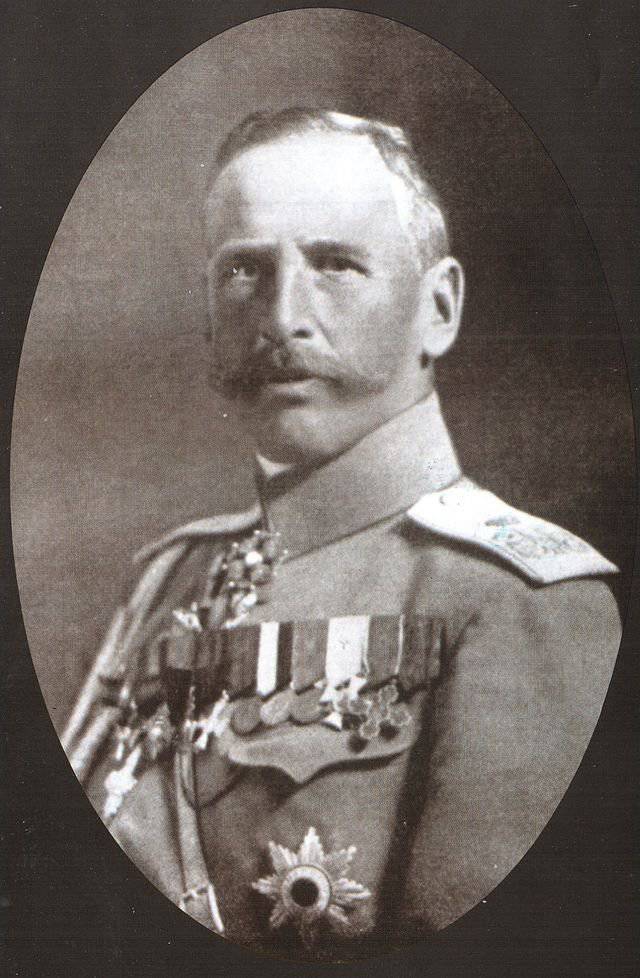
The commander of the Russian 10-th Kav. divisions lieutenant general count F.A. Keller
Movement 8-y army. On the front of the 8 Army, the Austro-Hungarian forces of August 17 captured Kamenetz-Podolsk and, under the threat of shelling, demanded a contribution from the townspeople. Concerned about the commander’s front, Ivanov demanded that Brusilov send troops to the left flank of the army and knock the enemy out of the city. But Brusilov and the chief of staff Alekseev correctly pointed out that the forces should not be scattered, after the onset of the offensive, the Austrians themselves would leave therefrom so that they would not be cut off from the main forces. This is what happened.
The 8 Army under the command of Brusilov launched the 5 (18) attack in August. It consisted of three incomplete corps (139 thousand soldiers with 472 guns). Soon, the army had to reinforce another, 24 body and approach three Cossack divisions from the Caucasus. For three days, the army reached the state border line on the Zbruch River and 7 (20) in August forced the river. Having barely learned of the Zbruch’s crossing by Russians, the Austrians left Kamenetz-Podolsk and returned the indemnity (the Russians could respond with the same coin, forcing the Austrian towns and villages to pay). 10 (23) August troops of the Brusilov River Seret, and then Strypu. Austrian troops surrendered these lines without a fight.
Only on the Koropets River of August 25 did the troops of the 8 and 12 corps have to endure stubborn battles with the Austro-Hungarian troops. Trying to delay the offensive of the Russian troops, the Austrian command struck a blow by the forces of two divisions. However, to delay the Russian offensive failed. The Austrian troops were overthrown and fled, leaving behind artillery.
The chief of the Austrian General Staff, General Konrad von Gettsendorf, believed that because of the incomplete mobilization, the Russian armies would begin the offensive in this sector later, in about two weeks. A strong blow on the Lvov direction was unexpected for the enemy. From the Balkan (Serbian) Front, the troops of the 2 Army began to hurry to Galicia.
The commander of the front, Ivanov, in view of the difficult situation of the 4 Army, somewhat changed the order of movement. The 3 Army of Ruza had to reach the Kamenka-Busk-Dunayuv line by August 25. 8-I army Brusilov attacked the line Vybudov - Monasterzhisk. The right flank of Ruzsky’s army was supposed to quickly reach the Zolkev area and thereby reinforce the flank of the Plehwe 5 Army, aimed at assisting the 4 Army. After further worsening the situation of the 4 army, Ruzskoy received an order to send a large part of the army north of Lviv, threatening the flank and rear of the Austrian 4 army. However, Ruza was in no hurry to carry out this instruction. The 8 Army was also shifted north. With its right flank, it had to attack Lviv, and its left flank against Mykolaev.
At this time, the 3-I Austrian army of Bruderman occupied the front Busk - Bortkuv - Peremyshlyantsy - Blotnya. The left flank was ensured by the 44-I landver division and the 11-I cavalry division in the area of Kulikuva - Zhultance. The right flank was covered by the 11 Infantry and 8 Cavalry Divisions in the Brzezany area. In addition, to the south, at Stryi and Stanislavov, the head units of the 2 Austrian army began landing.
On August 24, the commander of the Austrian 3 Army received an order to launch an offensive from the Lvov area and deliver a "serious blow" to Russian troops in the direction of Brody and Tarnopol. This was a mistake by the Austrians. The advancement of the army forward, to gain time and space, was the right decision. But for the "strong blow" the Austrians did not have the strength. The 3 Army was significantly superior to Bruderman’s forces even without the support of Brusilov’s 8 Army. This led the Austro-Hungarian troops on the Lvov direction to complete exhaustion in the first battles. As a result, the 3-I Austrian army could not already organize reliable defense on other lines and did not win the time needed to complete the offensive operations of the 1-th and 4-th Austrian armies. A smarter decision would be a battle with the Russian troops on the method of mobile defense. The mobile (maneuverable) battle allowed to gain time and save the main forces.
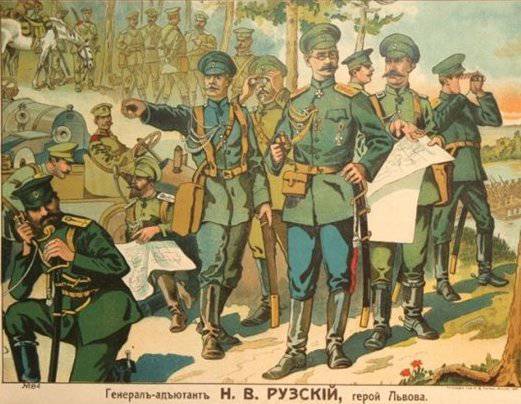
Adjutant General N.V. Ruzsky. "Hero of Lviv". Postcard from the First World War
Battle of the Golden Lipa River
By the evening of August 24, the army of Ruzsky reached the line Radzikhov - Sokolovka - Sassov - Yezerna. On 25 August, a rest was scheduled. At the same time, the army Brusilova crossed p. Strypu on the line of Plotych - Vysyuvchik Parts of the left-flank 24 corps were located somewhat in front and on a ledge on the Kurdvanovka-Monastrezhiska line. Ahead of the corps was Pavlov's cavalry — the 2-I Kuban and Combined Don Cossack Divisions.
As a result of the movement of the Russian and Austrian troops 26 August a major oncoming battle began. The right-flank 21 Corps began fighting in Busk. In the center, Russian troops successfully attacked: the 11 Corps, after a stubborn battle, took Skvarza-Ves, the 9 Corps suppressed enemy resistance from the Prince and fought off an enemy strike on the front of Gologura-Zhukov. The left-flanked 10 corps was also successfully attacking. Russian troops pushed the enemy for the river. Golden Lipu, but the 60-division of the 10 corps during the further attack on Dunayuwu was driven back to the Pomorjan. As a result, the Austro-Hungarian troops failed to deliver a “strong blow”. Bruderman’s army was unable to succeed, suffered heavy losses and went on to defensive in the first serious clash with the Russians.
It is necessary to note the high morale of the Russian personnel army in the initial period of the war. Despite the heavy fighting and losses, the Russian soldiers and officers rushed into battle. In preparation, the Russian and Austrian armies (first divisions) were approximately at the same level, but the Russian troops were distinguished by higher combat capability. Austro-Hungarian troops quickly exhaled, and even with success, lost their offensive spirit. Russian soldiers fought steadfastly even in the most unfavorable conditions. And the offensive inspired them, they increased tenfold their forces.
To fulfill the instructions of the front command, Ruzskoy planned to turn to the north of the 21 and 11 corps, which were to go to the Kamenka-Mosty-Velke area. However, the battle that had begun allowed Ruzsky to ignore the order of the high command. The command of the Southwestern Front repeated the order. The commander of the 3 army did not follow and re-indication. Ruza's troops continued to attack by the main forces in the Lviv direction. As a result, this worsened the situation of the 5 of the Russian army, which fought hard with the superior Austro-Hungarian forces in the areas of Zamostya and Tomashov. In addition, the 14 th Austrian corps of Joseph-Ferdinand, who will bypass the left flank of the Plehwe army, was located at that time in the Butyni area - Mosty-Velke. Thus, an earlier turn of part of the forces of the army of Ruza to the north could radically change the situation on the right flank of the South-Western Front. But Ruzskoy continued to persist, but the front command could not insist on its decision.
The Austrians also continued to make mistakes. Bruderman, despite the heavy losses of the 3 Army, decided to continue the attempts of the offensive. The left flank of the army — the 11 corps — struck at White Stone, the right-flank reinforced 12 corps — at Pomorgany, Chizhov, bypassing the left flank of the Russian army. In the center of the defense held 3-th corps. The 14 Corps of Joseph-Ferdinand received the task of attacking the Kamenka. The right flank on the Dunayuv-Rohatyn line was provided by the 11-I infantry, 4-I and 8-I cavalry divisions and one landscape team.
On August 27, Russian troops bravely withstood the first onslaught of the enemy and began to push it. The Russian 21 body pushed the Austrian 11 body back first to the line Zhelehov, Busk. Then the Russian troops took Busk. In the center of the 11 and 9, the Russian corps advanced and entered the Krasne-Vishnevchik line. Thousands of people were captured by 3,5, 32 guns were captured as trophies. On the left flank, the 10 body by the evening was shot down by the reinforced Austrian 12 body at Cemierzian. To establish contact with the army Plehve to Mosty Velke on the river. The 11 Cavalry Division was sent to the Rat. To support communication with Brusilov’s army, an equestrian group of three cavalry divisions was formed on the left flank of the 3 Army. At the same time, Ruza, considering that his left flank was under threat, turned to Brusilov for support.
Thus, the 3-I Austrian army in a three-day oncoming battle on the River Golden Lipa suffered a heavy defeat and suffered heavy losses. Bruderman began to withdraw troops to the line of the Rotten Lipa River. And the waste in places went into flight.
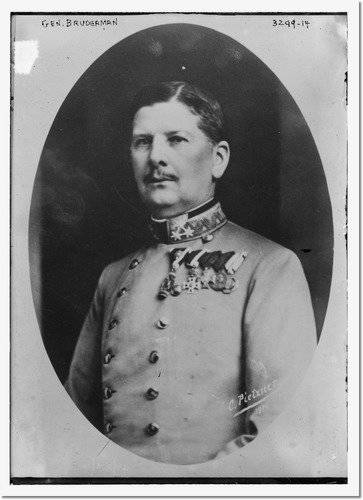
General broderman
Battle of the Rotten Lipa River
The left flank of the Austrian army was located at Zhultance. In reserve there was one division in the Lviv area and one and a half division in Kulikuv. The right flank was supported by two cavalry divisions in the Rogatin-Podkamen area. Parts of the 2 of the Austrian army continued to concentrate at Galich and Rogatin.
After the battle on the river. Golden Lipa Ruzskoy wanted to give the army a rest on the 2-3 of the day in order to put in order parts and rear units, as well as conduct reconnaissance in the Lviv direction. He was supported in this decision by the front command. However, the Russian Stavka had a different opinion. The High Command gave the order to continue the offensive of the 3 and 8 armies by all means, to prevent the enemy from regrouping forces, to transfer reinforcements, to organize the defense of Lvov. Therefore, the 3 Army continued its offensive.
29 August Russian troops continued to crowd the enemy. The 21 and 11 Russian enclosures reached the Sapezhanka-Khreniów line, the 9 and 10-corps reached the Unterwald-Rotten Lipa line. Particularly stubborn fighting took place on the Austrian fortified line on the highlands between Turcocin and Krosenko. The 7 Corps and the 12 Cavalry Division from Brusilov’s army entered the southern flank of Ruzsky’s army. On 30, August Ruzskoy planned to continue the offensive on the Lviv direction by the main forces of the 3 Army and the 7 Corps of the 8 Army. The rest of Brusilov's troops were to provide the flank of the 3 Army.
The Austrian command, misled by its intelligence, believed that the Russian cavalry was advancing to the south of Tarnopol and Rogatin. Therefore, on August 14, the Austrians decided to inflict two main blows: the 30 Corps along the Lviv-Brody railway would go on the offensive, and the army reserve in the 11 1 / 1 division had to bypass the right flank of the Ruzsky army. In addition, the troops of the 2 Army were to launch an offensive in the Galich area.
At this time, the front command decisively intervened in the plans of Ruzsky. The army of Brusilov was not to perform the function of a cover, and also to actively advance on the Lvov direction. Ruzsky was ordered to allocate up to half of all cavalry for action in the north, threatening the rear of the 4 Austrian army. One corps of the 3 Army also had to start moving in the direction of Kamenka - Rava-Russkaya. The Russians still wanted to be forced to help the army of Plehve. At the same time, Ruzsky was charged with responsibility for both armies of the southern wing of the South-Western Front and for the defeat of the enemy troops in the area of Lviv, Mikolaev and Gorodok.
30 August Russian troops continued to break the resistance of the enemy. The left wing of the army - 10, 9 of the corps, with the support of parts of the 8 corps of the 8 army, broke through the enemy defenses in the area of the villages of Peremyshlyany and Brzhuhovitse, seized 28 guns. When the 10 Corps broke through the enemy defenses near the village of Brzhuchowice, the 10 Cavalry Division entered the breach. Russian cavalry forced the Rotten Lipa, caught up with the columns of the retreating Austrians and turned the enemy to flight towards Svirzh. In this battle, 5 howitzers and many prisoners were captured. However, success was not developed, since the actions of the 10 division were not supported by the nearby two other cavalry divisions.
This battle once again showed the importance of cavalry raids after breaking through defenses and the action of cavalry in the enemy’s rear areas. With a decisive and skillful commander, cavalry formations did amazing things. However, the same case showed that the potential of cavalry in the Russian army at that time was not fully utilized. The same disease was noted during the Russian-Japanese war (Battle of Liaoyang), although the Japanese did not have cavalry equal to Russian in capabilities and combat capability.
In the center of the 11-th corps captured Zhuravniki. The 3 Austrian Corps began to retreat directly to Lviv positions. As a result, the Austrian troops suffered another defeat, and began to retreat, leaving most of the equipment on the battlefield.
In the meantime, Brusilov’s army was also successfully advancing. The 12 body took Rogatin, the 8 body with the help of parts of the 24 body forced the river. Rotten Lipa and defeated the Austro-Hungarian troops in the area Gelibory. An 31 gun was captured. Austrian troops ran towards Galich. However, they could not organize his defense.
Thus, during the two-day fighting 3-I Austrian army suffered a new defeat. Bruderman gave the order to withdraw to the line Lviv - Crassus. At the same time, the head of the General Staff, Conrad von Götzöndorf, ordered to keep Lviv as an important political center of Galicia at all costs. It should be noted, Lviv, in fact, was a fortress for a long time. However, the Russian command did not know that the fortress had been abolished before the war, and the guns from the forts began to be removed. The Austrians planned to win the battle in the field, not considering the need to improve the fortifications of the Lviv fortress.
31 August Russian troops pursued a moving enemy forces. Ruza's army entered the outskirts of Lviv, going on the line Zhultanets, Yarychuv and Barshovitsa. The northern flank of the army (21 Corps) threw the enemy off the village of Kulkuv. Brusilov’s army entered the right bank of the Rotten Lipa River, capturing the enemy’s guns and a large number of prisoners for 70 battles. The Dniester detachment Pavlova moved to Nizhniyov.
On the whole, the position of the Russian armies was brilliant, the enemy was defeated in all directions, demoralized and retreated, throwing heavy and light guns, carts and wagons. Thus, Brusilov’s army, almost meeting no enemy resistance, reached the line of Bobrk - Khodorov. The Austrians fled towards Lvov and Mikolaev.
The defeat of the Golden and Rotten Lipa and the retreats to Lviv of the 3 and 2 of the Austrian armies greatly alarmed the Austrian General Staff. It was decided to transfer the center of gravity of the operation to the Lviv direction. The situation on the front of the 4 Army and the departure of the 5 Army Plehve created the opinion of the Austrian command that the Russians in the Lublin sector would not recover soon. Therefore, they decided to single out Plehve’s 5 Army (it was not defeated, but only orderly relegated to the best positions, retaining full combat capability and morale) and covering the flank of the 1 Army by Joseph-Ferdinand. The main forces of Auffenberg’s 4 Army decided to abandon Bruderman’s 3 Army. Three Austrian armies were to organize a counterattack on the Lvov direction: the 3-I army should restrain the Russians at the front, and the 2-I and 4-I armies to deliver flank attacks. The news of the fall of Lviv and the retreat of the 3 Army to the Gorodok positions (Vershitsu River) only approved the Austrian command in this plan.
Liberation of Lviv
Meanwhile, the Russian troops continued their victorious offensive. 2 army The 8 army took Galich, where they captured enemy guns and machine guns (the garrison fled after the first attack), Pavlov's detachment immediately captured Stanislavs. Cossacks rushed into the raid on the enemy’s rear on Kalush and Stryi. Ruza, despite all the orders of the front command to turn part of the troops to the north, to the aid of the 5 Army, he remained deaf to them and continued the offensive on the Lvov direction. September 3 front command reiterated instructions to turn part of the army to the aid of the 5 Army.
On the same day, September 3, without a fight, Russian troops occupied Lviv. It was unexpected for Ruza. It was assumed that the Austrians would defend fiercely. Ruzskoy even ordered the troops to be extremely careful. Did the Austrians have a trap? However, fears were in vain. The Austrians abandoned a major center without a fight. Austro-Hungarian troops temporarily lost their combat capability.
Only after that Ruza began to organize actions against the 4 of the Austrian army. The right flank of the army (21 and 11 corps) was sent to the Parhach-Bridges-Velke line. Their left flank was supported by the 9 Corps, which advanced into the Kulków area. The remaining two army corps, 10 and 12, were sent around the Gorodok position of the Austrian army from the north in the villages of Lelehovka, Stradch and Rzhensk-Polskaya. Army Brusilov was to support the attack on the town.
Results of the operation
3-I of the Austrian army of Bruderman was defeated in two battles on the rivers Golden Lipka and Rotten Lipka. Well-fortified enemy positions fell, Lviv was taken. The main reason for the defeat of the Austrian 3 Army and the 2 Army that approached it to the aid were gross command errors. Brederman's army received an order to go on the offensive, although it had not yet gathered all its forces, it did not wait for the arrival of units of the 2 Army. In her position, the best method would be mobile defense, with a time gain and the preservation of the main forces.
The Austrian command overestimated its capabilities and underestimated the enemy, poorly organized intelligence. The commander of the 3 th Austrian army, Bruderman, spent all his forces in oncoming fights and was no longer able to organize the defense of Lviv. By the time the Austro-Hungarian troops retreated to Lviv, they had already lost their combat capability.
Although even after the defeat on the Golden Lipa, the Austrians had the opportunity to organize a defense on the line Lviv - Mykolaev, if they had immediately departed to it, without heavy fighting on the Rotten Lipa. The approached reserves, parts of the 2 Army, were spent in bloody battles at the turn of the river. Rotten Lipa and Lviv remained without protection.
Among Ruzsky's mistakes, it is worth noting that he ignored orders from the front command to assist the X-NUMX Army of Plehve. At the most crucial moment, starting from August 5, the 26 Army could have a serious impact on the situation on the front of the 3 Army, threatening the flank and rear of the 5 Austrian Army. This would have had a positive impact on the overall situation on the right wing of the South-Western Front. However, Ruza chose to focus all attention and power only on Lviv. Although Lviv could have taken the right flank of Brusilov’s army. In addition, the 4-I army limited itself to purely frontal blows, grinding the enemy troops in oncoming battles. Superiority in forces was not used for maneuvering rounds or covering the enemy. The impact force of the Russian troops led to success and frontal battles, but led to unnecessary losses and expenditure of ammunition.
Brusilov exerted excessive attention to his left flank, an imaginary danger due to the Dniester. Pavlov's detachment seemed to him weak to cover the left flank of his army. Brusilov, himself a cavalryman in his service and having numerous cavalry, did not use it to organize long-range reconnaissance in front of the left flank, which could show the absence of a threat. As a result, half of his army virtually inoperated the entire operation, “covering” the right flank of the 8 Army, which contributed to the offensive of the Ruzsky troops. And with the active action of cavalry on the left flank of Brusilov’s army, there appeared the possibility of deep coverage of the enemy’s Lviv grouping. However, she was missed.
From the prisons and camps of Galicia, tens of thousands of interned Russians, Ruthenians, arrested for "Russophilism" (most often just for a rash word), were freed. Rusyns greeted the liberators with enthusiasm. There were almost no differences between them and the Russian Great Russians. Ordinary Galicians perceived Russians as “theirs”. The Poles were also friendly and they hoped for the liberation of the vast Polish regions that were part of Austria during the divisions of the Commonwealth. A hostile position towards the Russians was occupied by the Uniate Church, the Germans and the Jews. But this position was limited to oblique views. Active actions opponents of the Russians were afraid to undertake.
The Russian authorities were friendly towards everyone. A civil administration was established headed by Count Bobrinsky. Began to build a peaceful life. There were no contributions and repressions, as well as religious persecution. After the war, the Poles were promised to unite the Russian, Austrian and German parts of Poland and to grant it broad autonomy within the Russian Empire.
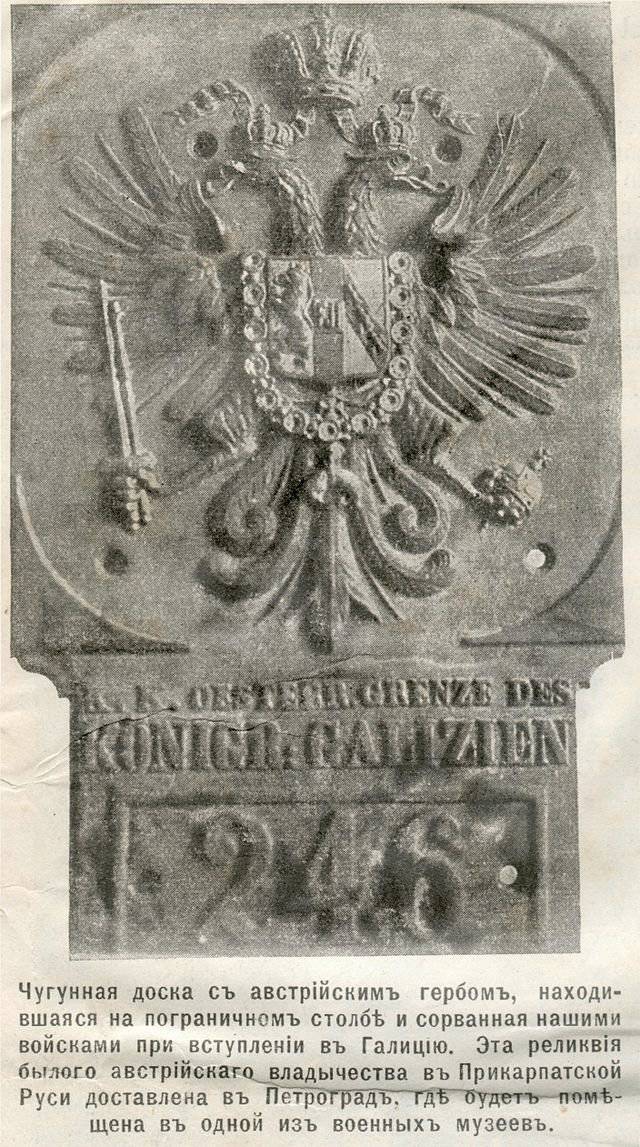
The trophy of the Russian army is the Austrian frontier coat of arms "Galicia". 1914 year
To be continued ...
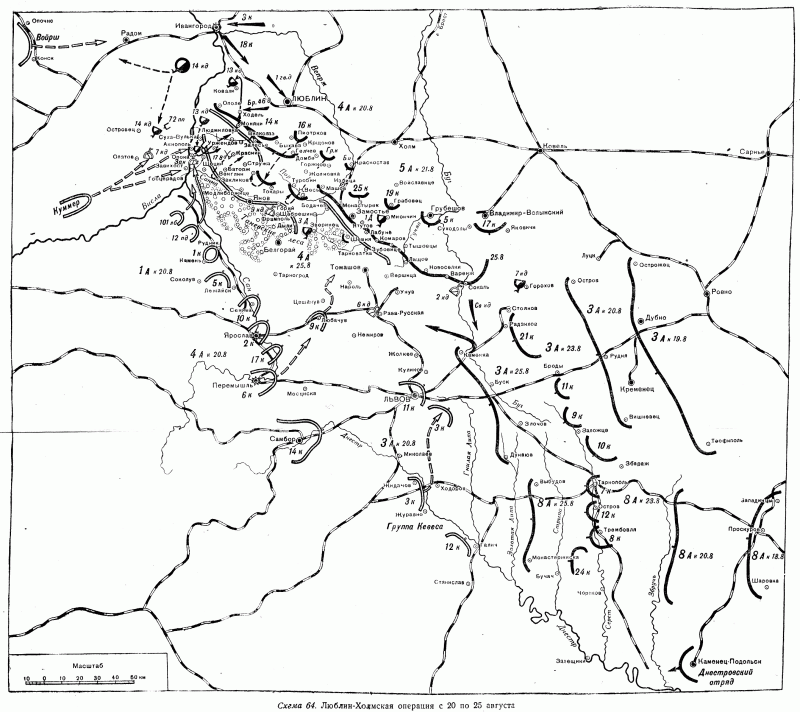
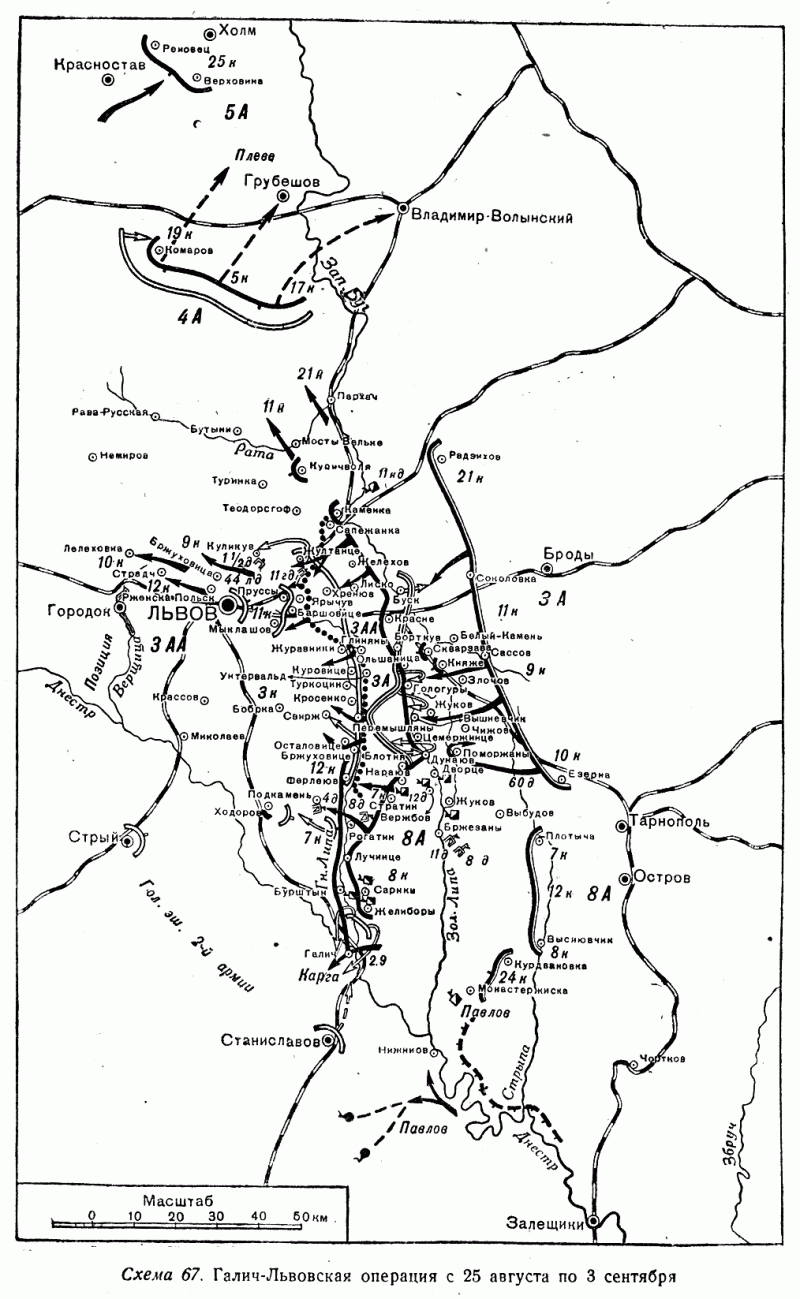
Information